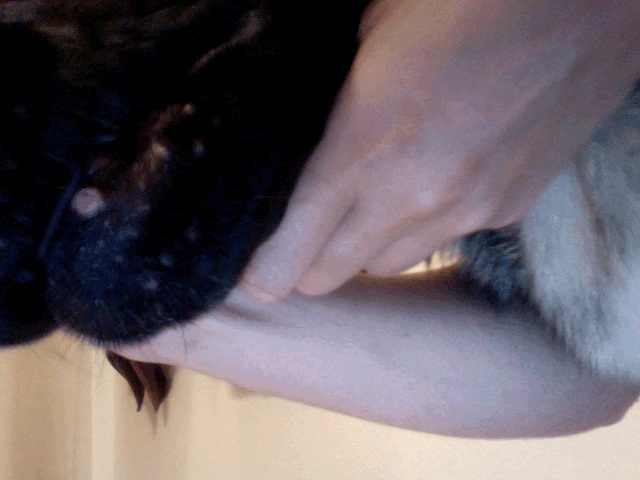QuestionHELLO AND GOOD EVENING. WE RECENTLY ADOPTED A 9 MO. OLD WHITE GERMAN SHEPARD. I HAVE HAD STANDARD SHEPARDS ALL MY LIFE. BUT MY FIRST WHITE. HE SEEMS TO HAVE A RASH OF RED SPLOTCHES AROUND HIS STOMACH. WE HAVE HIM ON FLEA PREVENTATIVE AND BATH HIM BI-MONTHLY. MY QUESTION IS, DO WHITE SHEPARDS SEEM MORE PRONE TO SKIN CONDITONS THAN STANDARDS. AND IF SO ANY SUGGESTIONS, CURES ?
THANK YOU IN ADVANCE
SCOTT GREGORY.
AnswerHi Scott!
Rashes
Most rashes in dogs are not the typical allergic rash that we usually think of when we ourselves "break out". More often these rashes are actually infected hair follicles, similar to "pimples" in people. The infections are caused by bacteria that are found naturally on the skin and that multiply and cause problems only when the conditions are favorable. The type of rash that involves infected hair follicles is called "folliculitis." When seen on the non-haired areas of skin, the "pimples" or infected follicles may actually look like the "whiteheads" that we are used to on ourselves. Many times, especially on areas with fur, one never sees this "pustule" phase, called so because the bumps contain small amounts of pus . What is more commonly seen is the small crust or scab that forms at the base of the hairs. The scab later sloughs off, taking a small group of hairs with it. The next stage is the healing phase and the typical lesion has a characteristic expanding ring-like appearance that is sometimes confused with "ringworm" (a fungal infection.). The lesion has a reddish outline, rimmed by a narrow band of scaly skin, and has darker colored skin in the center. On haired areas of skin, all you usually see of this stage is a small bald patch with a darker skin tone.
Causes of Folliculitis
It is rare for folliculitis to occur without some sort of triggering factors. Allergies are the most common triggers. Studies have shown that with allergies there is an increase in total numbers of normal bacterial and yeast inhabitants of the skin. Therefore, if conditions are favorable for growth, there are more organisms already available to cause infection than there would be under healthier skin conditions. In addition, the allergic reaction itself causes pruritus (itchiness), which stimulates the dog to lick, scratch, or rub the skin, physically traumatizing the skin and hair follicles and making both more susceptible to infection. Add moisture from saliva (licking) or from seeping areas of inflammed skin, plus perhaps some excess skin oils and scaly debris and you have the perfect breeding ground for both bacteria and yeast. Other conditions that promote folliculitis are excess moisure, skin oils, and bacteria trapped against the skin by a dense hair coat or folds of skin; and "old" hair left trapped in hair follicles because of inadequate shedding (from insufficient grooming). Once folliculitis occurs, it is difficult for the body to correct the situation without the addition of both antibiotics and topical treatments.
How Folliculitis can mimic allergies
The trouble with folliculitis is that it is often very difficult to detect unless it is severe. Each hair follicle is quite inconspicuous and, even when many hair follicles are affected, only careful examination by sight and touch can reveal that there is a problem. Some clues to folliculitis are the signs that it has "come and gone" in some of the hair follicles: small patches of hair loss, hairs or clumps of hairs that fall out with small scabs attached, or subtle bumps or irregularities in the skin under the hair. The reason that folliculitis is often confused with allergies is that folliculitis can be pruritic all by itself, as are allergies. Because folliculitis often occurs simultaneously with allergy problems or shortly thereafter, as a secondary problem, it is easy to forget the folliculitis and just to treat the symptoms of allergies. When dogs with folliculitis are put on Prednisone or given some other steroid to control allergic symptoms, the folliculitis often gets worse and may develop into a wide-spread or deep infection. Steroids change the skin cell replacement cycle, causing plugging up of hair follicles and suppressing the skin's natural resistance to infection.
Treatment of Folliculitis
A word about the use of oral antibiotics for treating skin infections: for mild cases of folliculitis, the minimum recommended by most dermatologists is 3 weeks. For infections that have been present for a few weeks or months, the minimum is 4 - 8 weeks or longer. For most lesions where scarring is present, such as "lick granulomas", the minimum is often 12 weeks! The same 12 week minimum holds true for deep infections, where the infection has traveled into the deeper layers of skin, below the level of the hair follicles. There are some dogs who, because they get skin infections back repeatedly, need to be on a regimen called maintenance Pulse Therapy, where the effective antibiotic is given long-term at the initial single-dose amount, but less frequently, say, once daily or every other day instead of twice daily. One additional note: if the dog's infection appears to be gone but starts to return after 4 - 7 days, it probably never was really gone in the first place; if it waits longer than a week to return, it means that there is a new infection occuring, possibly due to the same underlying cause as the first one. In early cases of folliculitis, antibiotics need to be continued until at least one full week past what appears to be "cure." With chronic infections, the antibiotics need to be continued for at least two weeks past this point. This is very important in preventing recurrences!
In addition to treatment with oral antibiotics, adjunctive therapy is also helpful, such as the use of medicated shampoos and conditioners and improving the diet to promote general skin health. The topical therapies options are numerous and based on the skin type and specific problem.
Infected skin folds
In dogs that have excess folding of the skin, either from being overweight or from having folds typical of their body type, these folds hold moisture. The moisture can come from the environment (e.g. dew or rain), from the skin (e.g. seeping sores), from saliva, from tears (in facial folds), from urine, or from topical skin treatments that don't dry thoroughly. The bacteria that grow in moist, low-oxygen environment are different and usually much "nastier" than the ones that grow in dry areas exposed to air. Often times, surface yeast infections develop in addition to the bacterial infections. Many times, even with the best antibiotic for "regular" skin infections, a different regimen must be followed. Typical areas for these problems to occur are between the toes, the external genital area, the underarm (axillary) area, and the rear leg fold near the groin.
Yeast infections
Like bacteria, yeast are common secondary invaders when conditions are right. Yeast infections of the skin typically appear as fairly uniformly red areas with a scaly, oily appearance. The dog usually has a pronounced "doggy" odor. In the ears, the odor and redness are similar and the discharge is usually medium to dark brown. The type of yeast that dogs get on their skin and in their ears is called Malassezia and is different from the Candida infections that sometimes affect women. Malassezia is common in areas of the skin that have excessive oils, moisture, and skin debris. These areas tend to be the ears, in between toes, around the nail beds, in the underarm (axillary) and groin (inguinal) regions, under the neck, and around the anal area. Certain breeds seem to be more prone than others, such as Cocker spaniels, Basset hounds, and West Highland White terriers. Yeast infections are never the primary problem, so when there is an overgrowth of yeast, look for an underlying cause. Allergies are a common cause. However, if only the allergy is addressed and not the yeast, the skin problem will often persist. Sometimes all that is necessary in treating yeast is topical therapy: removal of the skin debris and oils and allowing good air circulation. However, when the body conditions are favorable and the yeast has gotten out of control, oral medication such as Nizoral is often needed, sometimes with a prolonged "maintenance" period of treatment.
In ears, mild cleansers using vinegar and boric acid as active ingredients are useful for keeping yeast under control. Most ear cleansers should be used no more than once a week or they may irritate delicate ear canal tissues. On the skin, shampoos and conditioners using chlorhexidine, vinegar, or benzoyl peroxide are useful for treating yeast. Benzoyl peroxide products are also particularly useful for cleansing excessive skin oils. Since yeast is always a secondary invader, one must be just as aware of the general condition of the skin as of the yeast that is being controlled on it.
In conclusion
Because skin problems so often have both primary and secondary causes, it is important to evaluate everything that is occuring, not just to concentrate on the most obvious problem. Usually, it is necessary to treat any secondary problems before the underlying problems can even be assessed, much less treated. Although a step-wise approach may take a little longer, the result is a much more accurate view of the "bigger picture." Since most skin problems in dogs tend to recur, having an accurate view of the "bigger picture" will tend decrease both the discomfort and the total requirement for medications over the course of your dog's lifetime.
Serious health problems. From hip and elbow problems, to bone diseases, to stomach disorders, to skin conditions, German Shepherd health can be really iffy.
Itchy skin is a very uncomfortable problem for many pets, and while itching can be caused by obvious culprits, such as fleas, sometimes the source of the problem is less obvious.
The skin is normally covered with various microorganisms such as bacteria and yeast. Usually these organisms do not cause any problems because healthy skin is resistant to infection. When an underlying disease compromises the immunity of the animal or changes the skin's susceptibility to infection, the bacteria that are already there have the opportunity to multiply and cause infection.
Skin infection can produce many symptoms ranging from moist, irritated patches to small pustules that look like pimples. Infections can arise as dry flaky circles that peel or the area may become itchy and red. Angus says, "Once an infection like this has a foothold, sometimes it can keep going even after the original cause of the infection is gone."
Another condition that can cause skin problems is allergy. Allergies often lead to secondary bacterial and yeast infections that can hide the presence of the allergy. After the infection is treated, and the odor, redness, and sores go away but the itching remains, the dog may still have an underlying allergy. Animals can develop allergies in response to many environmental agents including mold, pollen, and fleas.
In general, dogs get skin infections more frequently than do other animals. Certain dog breeds, such as German shepherds, cocker spaniels, golden retrievers, Dobermans, West Highland White Terriers, and breeds with lots of skin folds also seem to have a higher incidence of skin problems.
The best way to resolve skin infections is to identify the original cause of the infection and treat it. To treat infections that are on the surface of the skin, antiseptic shampoos and other topical treatments can be applied.
For infections that are deeper, oral antibiotics or antifungal drugs may be prescribed. "Like all medications," Angus noted, "they need to be given for the full course of therapy and not just until the condition looks better."
If you have any questions or you think that your pet may have a skin infection, contact your local veterinarian.
I hope this has been helpful and I wish you the best of luck!Please keep me posted and give that White German Shepherd millions of kisses for me!Sending wagging tails your way!
Nicole

 Mini Pin.. not activity
Question
Mini Pin 1 1/2 year ol
I have a 1 1/2 year old
Mini Pin.. not activity
Question
Mini Pin 1 1/2 year ol
I have a 1 1/2 year old
 Cat breed, safe for family?
Question
The kitten
I found a kitten a couple da
Cat breed, safe for family?
Question
The kitten
I found a kitten a couple da
 German Shepard has red sore on lip
Question
sore on charlies lip
The other day I no
German Shepard has red sore on lip
Question
sore on charlies lip
The other day I no
 LABRADOR HEIGHT
Question
TOBO
MY LABRADOR IS NOW 5 MONTHS OLD....
HIS H
LABRADOR HEIGHT
Question
TOBO
MY LABRADOR IS NOW 5 MONTHS OLD....
HIS H
 Female Tortie cat 7 years old
Question
Sadie
My cat sadie gets a re-occuring sore in
Female Tortie cat 7 years old
Question
Sadie
My cat sadie gets a re-occuring sore in